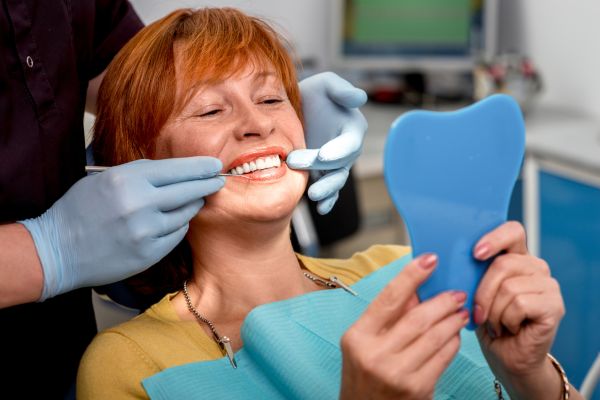All-on-4®: Can I Replace Multiple Missing Teeth?

Anyone researching tooth replacement is probably going to come across the term All-on-4®. However, most people may not know what this procedure is or what it can mean for them. For those who have multiple teeth missing or are going to have a procedure to remove multiple teeth, understanding the options is important. As you begin the process of restoring your smile, it is beneficial to learn why this procedure is so popular with dentists today.
What is All-on-4®?
This procedure essentially allows a dentist or oral surgeon to fully replace a patient’s teeth in one day. In the same day that teeth are removed, a full arch of teeth is installed. This is a large improvement over other methods that can require multiple surgeries to restore a patient’s teeth. The name of the procedure is derived from the fact that only four implants are required to secure the bridge device.
What are the benefits?
Patients considering the options may be intimidated by the cost of this procedure. However, there are many benefits to making the investment:
- Very fast turnaround time, with teeth extraction, implant placement and bridge installation all occurring in one day
- Reduces embarrassment and self-consciousness due to missing teeth
- Cheaper than a full set of implants
- Not as invasive as other procedures
- Less downtime since fewer surgeries are required
- Less likely to need bone grafting
- More convenient than standard dentures
How is this procedure different from implants?
Traditional implant-supported dentures require a large number of implant screws. In many cases, as many as 10 are required per arch. For patients wishing to have both their upper and lower jaw done, this could mean having up to 20 implants installed. Since this requires surgery, it usually means multiple visits and is impactful on the patient.
Alternatively, All-on-4® procedures are much less invasive. Only four implants are required per arch, which means for a full replacement of both upper and lower sets of teeth, only eight implants are needed. Also, the rear two implants are angled, which improves contact with the jawbone. This means there is less chance of a bone graft being required.
What is the process for installation?
Before the appointment, the dentist or oral surgeon designs and molds the bridge device to fit the patient’s mouth. On the day of the appointment, the patient is typically first put under anesthesia. Next, any teeth that need to be removed are extracted from the mouth. Afterward, the implants are surgically installed into the jawbone. This requires four implants for a single arch of teeth or eight for two arches. After the implants are set, the bridge device is affixed to the implants with screws.
Conclusion
As patients embark on the road of tooth replacement, All-on-4 is a helpful and convenient treatment option. This procedure generally provides immediate results with less downtime and surgical recovery needed. It can be a great choice for anyone who wants to restore their confident smile fast.
Request an appointment here: https://www.dentistryforwoodstock.com or call Dentistry for Woodstock at (770) 238-1437 for an appointment in our Woodstock office.
Check out what others are saying about our services on Yelp: Read our Yelp reviews.
Recent Posts
Getting a dental bridge for many missing teeth can renew your dental functions and oral health. It can even give you better self-esteem, knowing that your smile is complete. Your dentist will make sure that your restoration will feel and look natural. Here are the details when it comes to considering a dental bridge for…
Endodontics focuses on diagnosing and treating problems within the tooth's pulp and surrounding tissues. Endodontics can preserve its function and prevent further complications if a tooth is severely damaged or infected. Recognizing the signs that indicate the need for endodontic treatment allows patients to seek timely care and maintain their oral health.Persistent tooth pain is…
Losing a tooth can affect your appearance and oral health, causing misalignment, bone loss, and changes to your facial structure. Dental bridges are a popular tooth replacement option for people with one or more missing teeth. They offer a way to restore your smile and oral function.A dental bridge is a fixed prosthetic device that…
Dental bridges and dental crowns are wonderful, durable options to restore a smile. However, they are both employed for different reasons. By understanding the specifics of both, patients can learn which option is best for their needs when consulting with a dentist.Dental bridges are recommended after a tooth extraction, whether by trauma or professional intervention.…


